A shark’s brain works with all its senses. Shark’s brain has three portions – forebrain, midbrain, and hindbrain. Each portion performs a separate task with different senses.
In this article, I will describe in more detail how a shark’s brain works. Read on to find out more.
How Many Senses Do Sharks Have?
Sharks have seven different senses. Vision, hearing, smell, touch, and taste, electroreceptors, and lateral lines.
Vision
Sharks have excellent vision, enabling them to recognize potential prey’s size, shape, and color from a great distance. This plays a vital role in hunting and predation. Many sharks also can detect polarized light, which helps them locate prey hidden underwater by its silhouette against the light coming from above.
Hearing
Sharks have an acute sense of hearing and are able to detect even low-frequency sound waves produced by their prey. They can also use their hearing to navigate in murky waters when vision is limited. The inner ear of sharks contains a complex system of semicircular canals that they use to sense movement and direction changes.
Smell
Sharks have one of the best senses of smell in the ocean. They have an incredibly sophisticated olfactory system that can detect even the slightest odor of food items from many miles away. Even they can detect as little as one part per million of certain substances. This is what allows them to locate prey from far away and even track its movements.
Touch
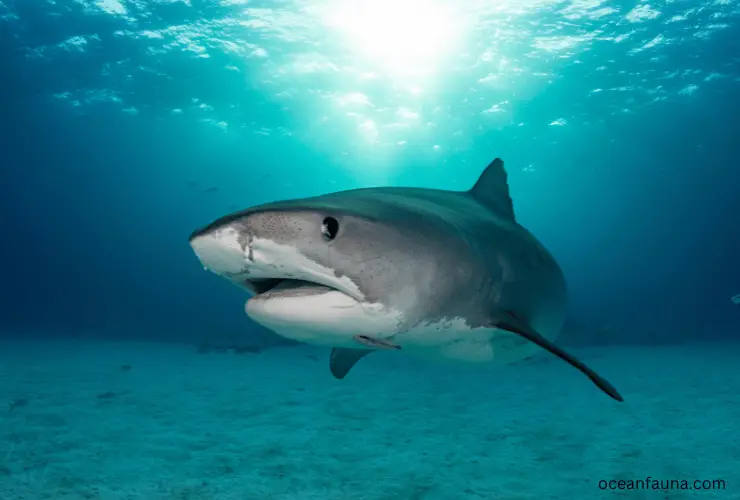
Sharks have sensitive electroreceptors in their snout, allowing them to detect electric fields generated by other creatures around them, including their prey. These receptors enable animals such as manta rays or hammerhead sharks to effectively hunt for buried prey in the sandy ocean floor with extreme precision.
Taste
Sharks’ mouths contain taste buds that help them determine whether a potential meal is palatable or not before actually consuming it. Sharks also have an upper jaw with taste sensors on the outside, allowing them to test the waters around them for potential prey.
Electroreceptors
Electroreceptors are nervous systems that allow sharks to sense electrical signals given off by prey and predators alike in water systems using ampullae of Lorenzini – small jelly-filled pores located on either side of a shark’s head above the eyes and along its lateral line (which runs along its flanks).
This allows these apex predators to track down small, fast-moving animals such as squid or fish, even in murky water conditions where visibility is severely limited due to poor lighting or sediment particles suspended in the water column.
Lateral Lines
Lateral lines are similar in function to electroreceptors, but instead of sensing electrical signals, they help sharks track pressure changes in their environment, allowing them to sense motion caused by other underwater creatures like fish, crustaceans, and aquatic mammals nearby – all this without ever having seen them before.
This specialized feature significantly improves the shark’s hunting capabilities thanks to its ability to quickly locate and target unsuspecting prey with speed and accuracy far superior to most other predators.
Structure of a Shark’s Brain
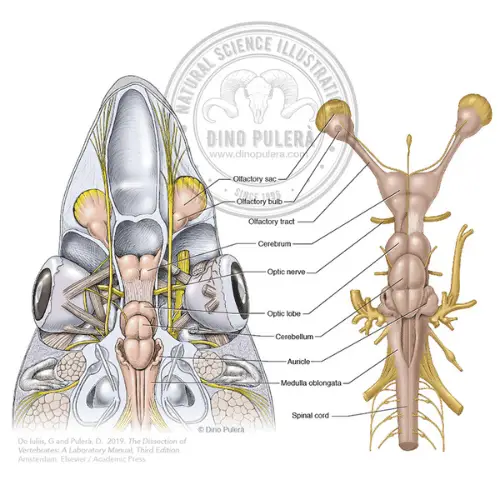
The shark brain features five main structures: the telencephalon, diencephalon, mesencephalon, cerebellum, and medulla. This highly-evolved organ provides these vital predators with a range of complex cognitive abilities unparalleled among other aquatic species.
Telencephalon
The telencephalon is the largest structure of the shark brain, and it is responsible for learning, memory, and behavior. It is composed of two cerebrums (the left and right hemispheres), which are connected by a band of nerve fibers called the corpus callosum. The telencephalon also contains sub-structures that are involved in processing sensory information from the eyes and ears, as well as controlling motor functions such as swimming.
Diencephalon
The diencephalon is an integral part of the brain responsible for regulating many complex functions such as sleep-wake cycles, feeding behavior, and hormone release. Its main components include the thalamus and hypothalamus. The thalamus processes sensory input from all parts of the body, while the hypothalamus controls biological processes such as eating, drinking, temperature regulation, and reproduction.
Mesencephalon
The mesencephalon is located between the telencephalon and the diencephalon in sharks. It aids in controlling movement. It includes structures like the midbrain tectum that are involved in visually guided behaviors like prey capture or navigating through murky waters. Additionally, this area houses neurons that control hearing, balance, and posture.
Cerebellum
The cerebellum is present exclusively in fish species with advanced central nervous systems, such as sharks. This structure has a very high density of neurons, and its primary function involves coordinating movements such as swimming or biting prey. It receives input from all over the body to help maintain posture and balance while moving in three-dimensional space.
Medulla
The medulla forms part of a larger structure called the hindbrain or rhombencephalon, which resides at the back of a shark’s head near its spine. This area houses neurons that are involved in autonomic functions such as respiratory rate control, heart rate regulation, and vasomotor reflexes (changes to blood vessels). Additionally, it controls balance when sharks move up or down during diving activities due to changes in pressure levels underwater.
How Does a Shark Brain Work?

A shark’s brain works by processing sensory input from its many senses to help it survive in its environment. The five parts of the shark’s brain that we talked about above are also divided into three classes that do different things: the forebrain, the midbrain, and the hindbrain.
Forebrain
The forebrain specializes in olfaction (smell) and gustation (taste). It is responsible for recognizing smells that may alert the shark to food or danger and tastes associated with known prey species. This portion of the brain also contains neuron pathways that regulate vital functions such as respiration and heart rate.
Midbrain
The midbrain is the visual center of the shark’s brain. It processes what the eyes see and helps identify potential threats or prey items in its vicinity.
Also, this section of the brain controls movements that aid in hunting, such as “steady swimming” swimbladder adjustments and changes in speed, direction, and orientation while tracking a target.
Hindbrain
The hindbrain is associated with hearing, tactile senses (touch), electroreception (ability to sense electric fields generated by other animals), and lateral lines—an organ system used to detect movement in the water around them.
This area of the brain facilitates sensory integration so that a shark can more effectively perceive its surroundings and make decisions about whether to pursue prey or flee predators.
Additionally, this region helps control escape strategies when needed and even assists with courtship behaviors when trying to find a mate.
How Intelligent Are Sharks?
Sharks are incredibly intelligent creatures, with some species displaying impressive problem-solving capabilities. For instance, the lemon shark is capable of learning how to navigate through mazes or find hidden objects in a short amount of time.
They can associate certain sounds with food rewards, indicating an acute sense of memory and decision-making abilities. In addition, some studies have shown that sharks can recognize individual humans and other predators.
In terms of their brains, sharks possess relatively large brains for their body size when compared to other fish species. It’s estimated that their brain-to-body ratio is comparable to that of birds and mammals, indicating a higher level of intelligence than many believe them to have.
Sharks also have highly developed senses for detecting prey or predators. This sensory prowess, combined with complex behaviors such as cooperative hunting, suggests that sharks are far more intelligent than was previously thought possible.
Moreover, the social behavior of certain species, such as the white-tip shark, displays complex learning patterns and group dynamics not typically seen in other animals.
For example, they are known to demonstrate leadership skills while hunting and actively cooperate with other members of the group. All these traits indicate a higher level of cognitive complexity than what was traditionally believed about sharks.
Does A Shark’s Brain Sleep?
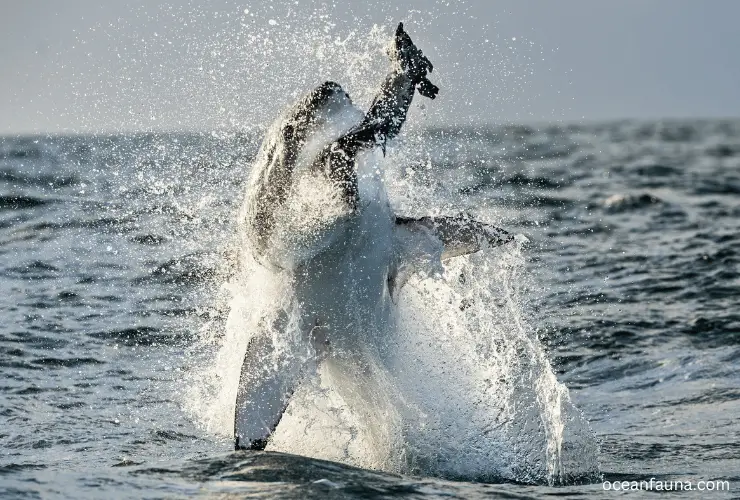
Yes, sharks’ brains do sleep, but only half of the whole brain Sharks experience a type of sleep known as unihemispheric slow-wave sleep (USWS), where one side of the brain is active, while the other side is inactive. This type of sleep has been observed in various species of dolphins, whales, and bird species.
In USWS, both eyes remain slightly opened and alert for potential dangers. During this state, sharks appear to be in a deep state of rest or relaxation as they drift slowly along ocean currents.
USWS allows animals to conserve energy by dimming down half of their brain while maintaining basic physiological functions such as breathing and circulation. It also allows them to remain slightly aware of their surroundings, so they can react quickly if there is any danger nearby.
Studies suggest that this type of sleep may be more common in aquatic animals because these environments are often very noisy due to the presence of undersea background noise, like waves crashing against rocks or currents moving through the water. Having only one hemisphere awake allows aquatic animals to filter out this noise and detect important acoustic cues more easily, such as incoming predators or prey items.
Sharks have been observed entering USWS from time to time throughout their day-night cycle, but it appears that much deeper forms of rest may occur at night when their activity levels are much lower than during the day.
In addition to USWS, sharks may also exhibit periods of normal deep restorative sleep where both hemispheres are completely shut off from the environment for extended periods.
However, since shark behavior during these times is largely unknown, we cannot be certain how often this occurs or what exactly happens during these states. Regardless, it appears that sharks’ brains do indeed get some form of restful sleep as part of their natural daily routine.
How Much of a Shark’s Brain Is for Smell?
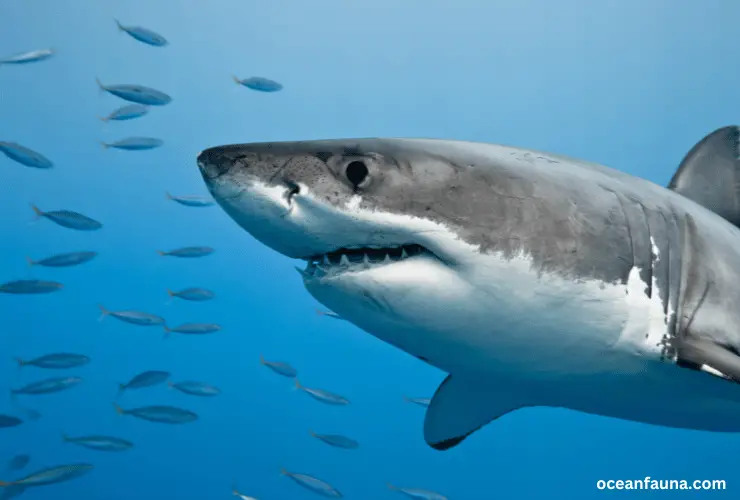
Two-thirds of a shark’s brain is dedicated to smelling, making it a vital sense to the animal. This means that roughly 66.7% of their brain is used solely for the smell.
A shark’s sense of smell is so powerful that it can pick up on some scents at incredibly low concentrations. Sharks are believed to detect one part per 25 million, which would be equivalent to being able to smell something from about a third of a mile away in the open ocean.
Sharks also possess a special organ called the olfactory bulb which helps them to detect odors and process them faster than other animals with the same sensory capabilities.
Sharks need to be able to smell to do many things in their lives, like find food, make babies, and stay away from predators.
The majority of sharks rely heavily on their sense of smell when it comes to finding prey. They are able to sniff out small traces of blood or other proteins released by injured or stunned fish, which may lead them directly to their next meal.
In addition, male sharks have been known to use their noses to locate female sharks during mating season, indicating that smell also plays an essential role in reproduction within these species.
Furthermore, sharks can use their heightened sense of smell as a way to avoid predators due to the fact that they are able to quickly detect the scent of another animal’s pheromones and thus know when they are in danger.
Overall, most species of sharks have evolved over time, with two-thirds of their brain explicitly devoted to smelling purposes due to their importance in everyday life for these animals.
By having such heightened senses through this specialized organ located in the nasal cavity, these aquatic creatures are able to utilize this power for survival and assist them in many ways, including locating food sources and evading potential danger from predators lurking nearby.
Conclusion
You now have a concise understanding of shark brain anatomy and functions. Sharks are one-of-a-kind creatures with an extraordinary sense of smell that helps them find food, reproduce, and escape danger. They can also enter an alert sleep state in which one side of their brain remains awake to notice warning signs or predators.
By understanding how sharks use their brains and senses, we can better appreciate these incredible creatures and perhaps gain insight into how our own brains might function.

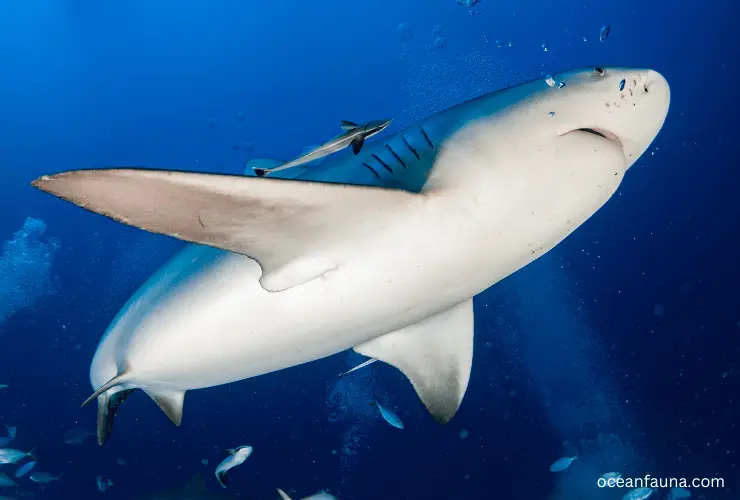
5 thoughts on “How Does a Shark’s Brain Work? [Structure & Function]”